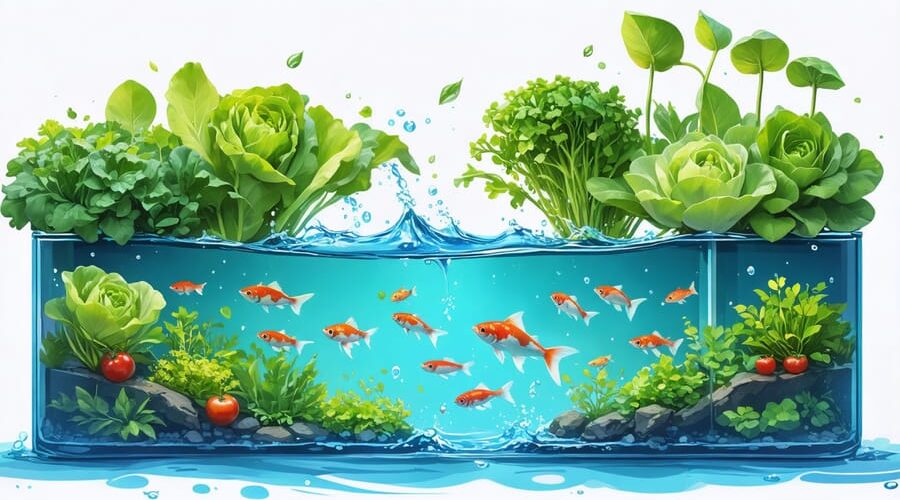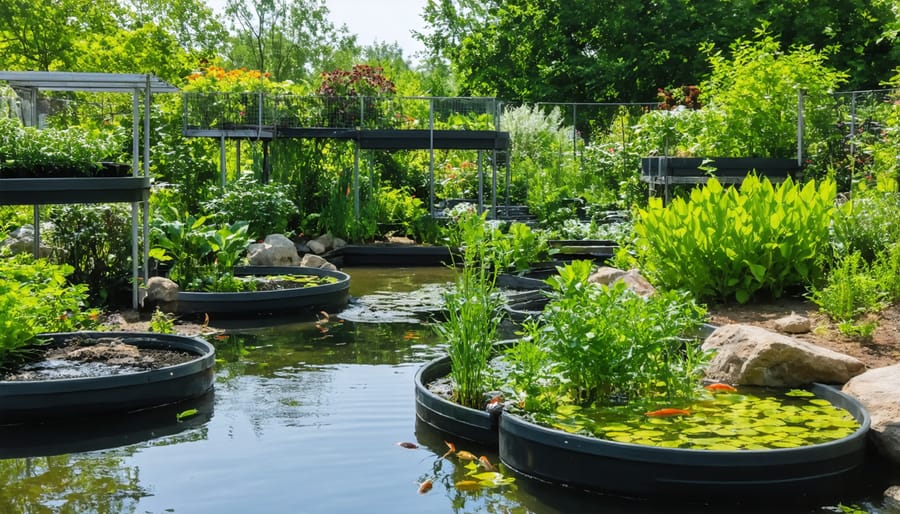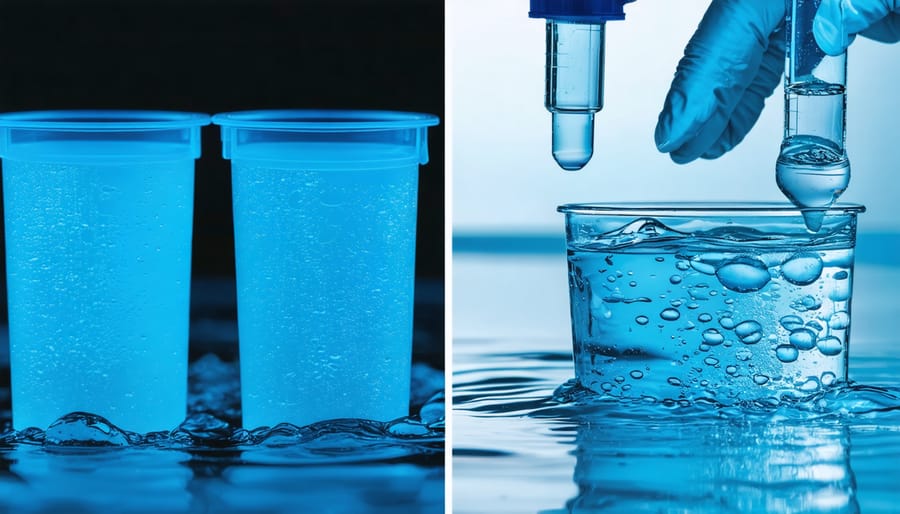
Fish Pond Aquaponics: Create a Self-Sustaining Water Garden Paradise
Transform your backyard pond into a thriving ecosystem that lets you grow fish and veggies together in perfect harmony. Fish pond aquaponics harnesses nature’s recycling power – fish waste feeds plants, while plants filter water for the fish, creating a self-sustaining food production system that’s both beautiful and practical.
Picture harvesting fresh lettuce, herbs, and tomatoes floating above crystal-clear waters where koi or tilapia swim below. This centuries-old farming technique has evolved into a modern solution for sustainable home food production, requiring minimal space and maintenance while delivering maximum yields.
Whether you’re a seasoned gardener or just starting your sustainability journey, pond aquaponics offers an elegant way to produce fresh, organic food year-round. The system’s natural balance means less work than traditional gardening, no chemical fertilizers, and up to 90% less water usage than conventional growing methods.
Ready to dive in? Let’s explore how to transform your existing pond or create a new aquaponic ecosystem that brings the future of food production to your backyard.
The Perfect Balance: Understanding Pond Ecosystems
The Fish-Plant Cycle
The fish-plant cycle in aquaponics is nature’s perfect partnership at work. Fish waste, which contains ammonia, is broken down by beneficial bacteria into nitrites and then into nitrates. These nitrates serve as natural fertilizer for your plants, which absorb these nutrients through their roots. As the plants consume these nutrients, they simultaneously clean and filter the water, making it safe for the fish to thrive.
Think of it as a continuous loop: your fish eat and produce waste, bacteria convert this waste into plant food, plants absorb the nutrients and clean the water, and the clean water flows back to your fish. This natural cycle creates a self-sustaining ecosystem where both fish and plants help each other grow.
The key to success lies in maintaining the right balance. Too many fish can overwhelm the system with nutrients, while too few might not provide enough fertilizer for your plants. Start with a modest number of fish and gradually increase as your system matures. Common plants like water lettuce, water hyacinth, and iris work particularly well in pond aquaponics, while hardy fish species such as koi and goldfish are excellent choices for beginners.

Beneficial Bacteria: The Hidden Heroes
Think of beneficial bacteria in aquaponics as tiny workers tirelessly converting fish waste into plant food. These microscopic heroes are the heart of your pond’s ecosystem, performing a crucial two-step process. First, certain bacteria transform harmful ammonia from fish waste into nitrites. Then, another group of bacteria converts these nitrites into nitrates – the perfect natural fertilizer for your plants!
These helpful bacteria naturally colonize your system, but you can give them a boost by adding store-bought bacterial starters. They thrive in your filter media, gravel beds, and on plant roots, creating a natural cleaning crew that keeps your water crystal clear and your plants well-fed.
To keep your bacterial workforce happy, maintain stable water temperatures and avoid using harsh chemicals that might harm them. Remember, a healthy bacterial colony means healthier fish, lusher plants, and clearer water – it’s nature’s perfect partnership at work in your backyard!
Setting Up Your Aquaponic Pond System
Choosing the Right Fish Species
Selecting the right fish species is crucial for a successful aquaponics pond system. Tilapia is often considered the gold standard due to their hardiness, fast growth rate, and tolerance for varying water conditions. These adaptable fish thrive in temperatures between 70-85°F and can handle slight fluctuations in water quality.
Another excellent choice is channel catfish, which are perfect for backyard ponds in temperate climates. They’re easy to care for, disease-resistant, and can tolerate cooler temperatures. For those in colder regions, rainbow trout make an ideal option, though they require consistently cool, oxygen-rich water.
Bluegill and other sunfish species are great native options for North American pond owners. These fish are naturally hardy and adapt well to aquaponic systems while adding aesthetic value to your pond. Carp species, including koi, can also work well, though they’re typically chosen more for their ornamental value than food production.
When choosing your fish, consider your local climate, pond size, and intended purpose. If you’re focusing on food production, fast-growing species like tilapia or catfish are ideal. For ornamental purposes, koi or goldfish might be better suited. Remember that different species have varying space requirements – generally allow 10 gallons of water per inch of full-grown fish.
Always check local regulations regarding fish species, as some may be restricted in your area. Start with a smaller number of fish and gradually increase the population as your system stabilizes.
Essential Plant Selection
Choosing the right plants for your aquaponics system is crucial for success. We’ve found that certain plants that thrive with fish create the perfect balance in your pond ecosystem.
Leafy greens are excellent starter plants for any aquaponics setup. Lettuce, spinach, and kale grow quickly and don’t require intense nutrients. These plants are perfect for beginners as they’re forgiving and provide quick results. Water-loving herbs like mint, basil, and watercress also perform wonderfully in aquaponic systems.
For those ready to expand, consider adding floating plants like water hyacinth or duckweed. These natural filters help maintain water quality while providing shade for your fish. Root vegetables such as carrots and radishes can thrive in grow beds with proper depth and media support.
Don’t forget ornamental options! Peace lilies and umbrella plants add visual appeal while effectively filtering water. For outdoor systems, try moisture-loving flowers like cardinal flowers or marsh marigolds to attract beneficial insects and add color to your pond.
Remember to start with just a few plant varieties and gradually expand as you gain experience. This approach helps you understand each plant’s needs and how they interact with your fish population, ensuring a thriving ecosystem for both plants and aquatic life.
Design and Layout Tips
When designing your fish pond aquaponics system, start by positioning your grow beds slightly above the pond level to allow gravity-assisted water flow. Place larger plants like water lettuce and watercress at the back of your growing areas, with smaller herbs and leafy greens in front for easy access and visual appeal.
Create a gentle slope in your grow beds (about 1-inch drop per 10 feet) to ensure proper water circulation. Install your pump at the deepest part of the pond, typically in a corner or central location, to maximize water movement. Position the outlet pipes so they create a subtle current that helps aerate the water without stressing your fish.
Consider sunlight patterns when laying out your system. Most aquaponic plants need 6-8 hours of direct sunlight daily, but some fish prefer shaded areas. Use taller plants or partial covers to create natural shade zones in your pond. Install your grow beds in a way that allows easy maintenance access from all sides.
For optimal flow, use multiple smaller grow beds rather than one large bed. This setup provides better water distribution and makes maintenance more manageable. Include small waterfalls or cascades between levels – they’re not just attractive, they also help oxygenate the water naturally.
Remember to leave enough open water surface for gas exchange, aiming for about 65% plant coverage to 35% open water. This balance helps maintain healthy oxygen levels for both fish and plant life.

Maintaining Your Aquaponic Paradise

Water Quality Management
Maintaining optimal water quality is crucial for the success of your fish pond aquaponics system. Regular water quality testing helps you monitor key parameters that affect both fish health and plant growth.
Start by checking your water temperature daily – most fish species thrive between 65-75°F (18-24°C). Use a reliable thermometer and try to maintain consistent temperatures, as sudden changes can stress your fish. pH levels should stay between 6.8 and 7.2, which provides a happy medium for both fish and plants.
Ammonia and nitrite levels should always remain at zero, while nitrate levels between 5-150 ppm are acceptable. Test these parameters at least weekly, or more frequently when first setting up your system. Dissolved oxygen is another vital factor – ensure good aeration through air stones or waterfalls to keep your fish breathing easy.
Keep an eye on water clarity too. Cloudy water often indicates an imbalance in the system. Adding beneficial bacteria can help establish and maintain the nitrogen cycle, especially in new setups. Remember to top up water lost to evaporation with dechlorinated water, and perform partial water changes only when absolutely necessary to avoid disrupting the ecosystem.
A well-maintained aquaponics system will develop its own balance over time, but it’s up to you to monitor and make adjustments when needed. Start a water quality journal to track changes and spot potential issues before they become problems. Your fish and plants will thank you with healthy growth and abundant harvests!
Seasonal Care Guidelines
Maintaining a fish pond aquaponics system requires different approaches throughout the year to ensure both fish and plants thrive in changing conditions. During spring, focus on system startup by gradually increasing feeding as temperatures rise and adding seasonal plants to your growing beds. Test water quality more frequently during this transition period as the biological system reawakens.
Summer demands the most attention to water levels due to increased evaporation. Install shade cloth to prevent excessive water temperature rise and algae growth. Monitor oxygen levels closely, as warm water holds less dissolved oxygen. Consider adding additional aeration during hot spells to keep your fish comfortable.
As autumn approaches, begin reducing feed portions as fish metabolism slows with cooling temperatures. Remove fallen leaves promptly to prevent decay affecting water quality. This is also the ideal time to harvest warm-season crops and transition to cold-hardy plants if you’re continuing production through winter.
Winter care focuses on protecting your system from freezing. In mild climates, reduce feeding to minimum levels and maintain water movement to prevent ice formation. For harsh winters, consider moving sensitive plants indoors and using pond heaters to maintain a small ice-free area for gas exchange. If you’re shutting down plant production, maintain minimal system operation to keep beneficial bacteria alive.
Year-round, keep a maintenance calendar to track seasonal tasks and system performance. Regular water testing remains essential regardless of season, but adjust frequency based on temperature and system activity. Remember that a well-maintained aquaponics system becomes more stable over time, making seasonal transitions smoother and more predictable.
Common Challenges and Solutions
Algae Control
Controlling algae naturally in your fish pond aquaponics system is essential for maintaining water quality and plant health. One effective method is introducing floating plants like duckweed or water lettuce, which compete with algae for nutrients and provide shade. Adding beneficial bacteria helps break down organic matter that algae would otherwise feed on.
Strategic placement of UV clarifiers can help control suspended algae, while maintaining proper fish stocking levels prevents excess nutrients that fuel algae growth. Regular removal of dead plant matter and fallen leaves keeps organic debris from decomposing and feeding algae blooms.
Barley straw is a time-tested natural solution – as it decomposes, it releases compounds that inhibit algae growth. Simply place mesh bags of barley straw in your pond, replacing them every 4-6 months. Adding oxygenating plants like hornwort or anacharis also helps maintain balance by consuming excess nutrients and producing oxygen.
Remember that some algae is normal and even beneficial – the goal is management, not complete elimination. Consistent monitoring and maintenance using these natural methods will help keep algae at healthy levels.
Fish and Plant Health Issues
In any aquaponics system, keeping both fish and plants healthy requires regular monitoring and quick action when issues arise. Common fish health problems include sluggish behavior, loss of appetite, and unusual swimming patterns. These symptoms often indicate poor water quality or stress. Test water parameters daily, checking for appropriate pH levels (6.8-7.2), ammonia (should be zero), and oxygen levels.
For plant health, watch for yellowing leaves, stunted growth, or signs of nutrient deficiency. These issues typically stem from imbalanced nutrient levels or incorrect pH. Adding iron supplements or adjusting fish feed quantities can help resolve many plant nutrition problems.
Prevention is your best defense. Maintain consistent water temperature, avoid overcrowding fish, and ensure proper filtration. If diseases occur, quarantine affected fish immediately and treat with appropriate medications. For plants, remove any diseased portions promptly to prevent spread.
Regular cleaning of filters and removal of plant debris helps maintain system balance. Remember that fish and plant health are interconnected – when one suffers, the other usually follows, so addressing problems quickly is essential for system success.
Fish pond aquaponics offers an incredible opportunity to create a sustainable, productive, and beautiful ecosystem in your backyard. By combining traditional pond keeping with the power of aquaponic growing, you’ll enjoy fresh vegetables, healthy fish, and crystal-clear water while reducing maintenance work and creating a more balanced environment. Whether you’re a seasoned gardener or just starting out, an aquaponic pond system provides endless rewards – from the satisfaction of growing your own food to the tranquil atmosphere of a thriving water garden. Don’t let the initial setup intimidate you; start small, learn as you go, and watch your system flourish. With proper planning and care, your aquaponic pond will become a source of joy, sustainable food production, and natural beauty for years to come. Take that first step today and join the growing community of aquaponic enthusiasts!
